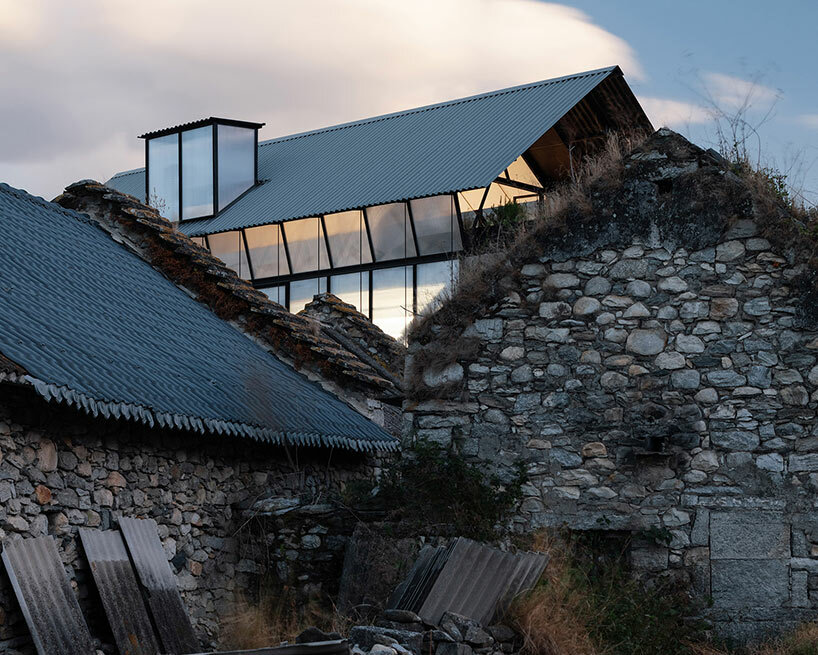ruins cave garden: a modern renovation in dali
Nestled beneath the mountainous landscape of China‘s Yunnan Province, the ‘Ruins Cave Garden’ is a a newly completed renovation project by ArCONNECT Architects, The project combines the landscape elements of the ruin, cave, and garden to embody the essence of its natural surroundings and to offer an immersive experience that bridges the gap between the past and the present. The project introduces a contemporary architecture studio and café to a structure which once stood as a stone ruin in the ancient village of Dali.
The urban fabric of this remote place — along the shores of the Erhai Sea near the border of Myanmar — has long been defined by traditional east-facing houses and inner courtyards. ArCONNECT’s new studio occupies a plot filled with disused structures including a well-preserved 1980s stone-wood house, and a 1990s brick-concrete structure. With this context, the architects aimed to connect the inward-looking courtyard with the expansive mountain and field landscape through a modern intervention.
 images © Chen Hao | @chenhao.etsam
images © Chen Hao | @chenhao.etsam
the framed landscape recalls traditional chinese paintings
With its ‘Ruins Cave Gardens’ renovation, ArCONNECT Architects’ merges design, demolition, and renovation with a hands-on approach. The architects initially focused on revitalizing the stone house and the north building, progressing in two phases. This resulted in an inviting space that combines historical charm with functionality, featuring public meeting rooms, a library, kitchen, dining areas, and private workspaces.
In redesigning the stone house, the team emphasized a connection with nearby Cangshan Mountain through the concept of ‘opening.’ This entailed creating a T-shaped opening on the west facade to invite natural light and enhance interior comfort. Meanwhile, vertical and ribbon windows frame sweeping views of the mountain and terraced fields, recalling traditional Chinese landscape paintings.

arconnect’s cavernous stone studio space
In homage to the skilled stone craftsmen of Dali, the ArCONNECT Architects’ ‘Ruins Cave Garden’ renovation celebrates the simplicity of the ancient ‘stone house.’ Exposing the stones hidden beneath the straw mortar, the transformation emphasizes the inherent beauty of the stone material itself. The interplay between rough stone and smooth glass, along with the immersive ‘cave experience’ created by 600 millimeter-thick stone walls, lends an engaging and tactile interior.
The stone house’s interior underwent a significant transformation, featuring a double-height reading area with a skylight and breathtaking mountain views. The corner staircase and topographical design led visitors to the second-floor private meeting area, further accentuating the connection between architecture and landscape. In contrast, the north building evolved from an introverted structure on the first floor to an open, light-filled space on the second floor, crowned by a rooftop space offering panoramic vistas of Cangshan Mountain and Erhai Sea.

the rocky garden and café
The second phase of the project prioritized a garden strategy to unify the site and create a more inviting environment. Integral to the design, the site’s ruins were extended and transformed into a layered rocky hill adorned with plants, alleviating the visual pressure from nearby buildings and directing focus towards the mountains. The inclusion of a deep pool and central courtyard well, filled with earth excavated from the ruins, further enhanced the garden’s topographical structure. The ‘corridor bridge’ served as a pivotal connecting element, diverting attention from tall buildings and fostering engagement with the garden.
The garden culminates in a so-called Ruins Garden Café emerging from the site’s ruins, its interactive structure integrating concrete furniture elements. The space is topped by an ultra-thin steel roof supported by steel plates and columns — seeming to defy gravity. The interplay of movement, sight, and space creates a seamless connection between the interior and the garden, forging a lasting bond between the past and the present.
 vertical windows frame the landscape to recall traditional Chinese paintings
vertical windows frame the landscape to recall traditional Chinese paintings
 the original stone structure is celebrated alongside the contemporary intervention
the original stone structure is celebrated alongside the contemporary intervention











